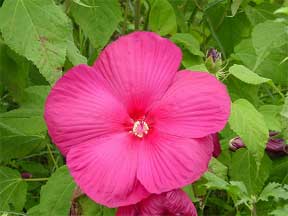Hibiscus Manihot, (pronounced MAN-e-hot) commonly called Sunset Hibiscus, offers high garden value to gardeners in search of a flowering plant that will endure the gridiron summer environment of Mid-America.
This hibiscus has been long overlooked but it is an amenable beauty, nonetheless. If started from seeds indoors during late February, and transplanted outdoors by early April, it will make a large plant from three to nine feet in height. Flowering begins by June with the stems bearing Hat, pale yellow blossoms with overlapping petals, four to nine inches across, with purple centers. The petal texture is thin, giving an ethereal beauty to the flower. By noon the flowers fade.

The leaves of Manihot are large and deeply lobed, something like maple leaves. In every stage the plant is interesting for its stiff, decorative foliage as well as for its bristly seed pods that follow later.
Manihot will winter over in more southern areas, although it loses its leaves. But it picks up so many nematode root knots during summer that most gardeners use it as a nematode trap, pulling it up and destroying its roots in the fall. In common with most mallows, Manihot is a host plant to nematodes but blooms anyway, so it has value in sandy soils where many other plants, not resistant to nematodes, cannot survive.
Another virtue of Manihot is that it will bloom in about six weeks from seed if planted as late as July. This makes it of value to the dilatory gardener who can plant Manihot seed along with lavender zinnias on the fourth of July and have colorful and harmonious bloom with little effort or later care.
